
Sard Gem: Info, Meanings, & Relation to Sardonyx & Carnelian
 Sard is a translucent, reddish-brown to brown chalcedony gemstone beloved since ancient times. The stone is related to fellow chalcedony gems carnelian and onyx, with all three being popular carving materials.
Sard is a translucent, reddish-brown to brown chalcedony gemstone beloved since ancient times. The stone is related to fellow chalcedony gems carnelian and onyx, with all three being popular carving materials.
If a stone named “sard” doesn’t seem like your style, don’t knock it just yet. Despite its potentially off-putting name, sard is a gorgeous gem. Its autumnal coloring and grounding properties make it perfect for anyone seeking some earthy vibes!
By the end of this guide, you’ll know everything there is to know about sard gemstone uses, healing properties, prices, meanings, and more!
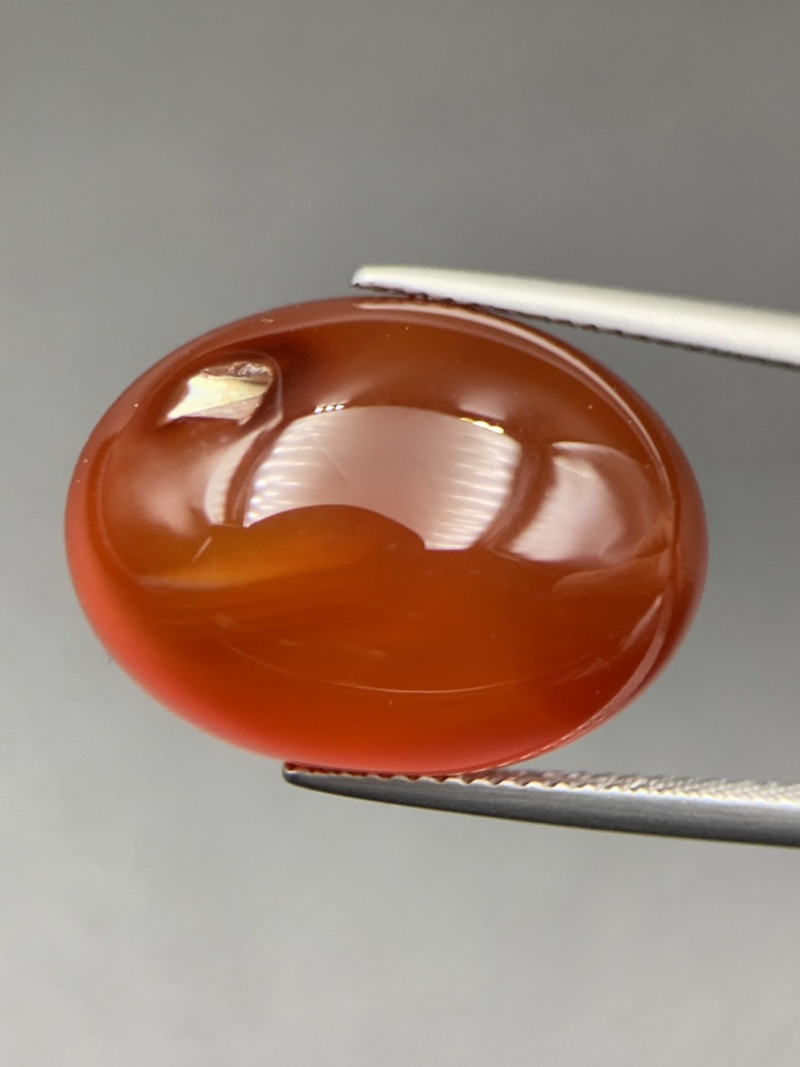
What is Sard Stone?
Sard is a deeply and uniformly colored stone widely known for mixing with onyx to create sardonyx.
Historically, both sard and sardonyx were among the most popular semi-precious gemstones, used practically for seals and decoratively for various accessories, including religious paraphernalia.
Ancient Romans and Greeks referred to sard as a “stone of fire” — perfect for its place as a star stone for Mars and a zodiac stone for fiesty Scorpio!
Maybe you were born during the fiery summer season Sardonyx is your birthstone, said to represent marital happiness. In fact, it was the first August birthstone, established in 1700s-era Poland.
Speaking of marital happiness, the similar gem carnelian commemorates the 17th wedding anniversary, and sard is a great substitute.
Moving on, what are the sard mineral traits?
Sard Specifications & Characteristics
The sard mineral is a variety of chalcedony, the microcrystalline type of quartz. The chalcedony gemstones are composed of silica. They’re similar to macrocrystalline quartz stones (e.g. amethyst) but form compact, fine-grained masses with crystals too small to see.
Unlike many chalcedony subtypes like the agate or jasper groups, the sard chalcedony stone doesn’t have color banding.
Here are all the sard mineral properties:
Mohs hardness: 6.5-7
Color: Reddish-brown, brown
Crystal structure: Trigonal
Luster: Vitreous (glassy), greasy, waxy, or resinous
Transparency: Semi-transparent to opaque
Refractive index: 1.53-1.54
Density: 2.56-2.68
Cleavage: None
Fracture: Conchoidal or granular
Streak: White
Luminescence: None
You know sard’s mineral side, but how does it compare to carnelian and sardonyx?
Sard vs. Carnelian vs. Sardonyx
Among chalcedony mix-ups, the most common confusion is between sard, sardonyx, and carnelian. Not only are they all chalcedonies, they share similar warm coloring in red, orange, yellow, and brown shades.
By names alone, sard and sardonyx often throw people for a loop. Let’s break down their distinction first.
 Pictured: Sardonyx
Pictured: Sardonyx
Sard vs. Sardonyx
Sardonyx is a type of onyx stone (another chalcedony variety) layered with sard, creating color banding that's usually in shades of red, orange, and white.
The easiest distinguishing feature between sard and sardonyx is sard’s lack of color banding. Plus, sardonyx has a mixture of light and bright hues, while sard tends to be dark.
You may assume that sard and sardonyx are more closely related than sard and carnelian, but that’s surprisingly not the case!
So, what is the difference between sard and carnelian?
 Pictured: Carnelian
Pictured: Carnelian
Sard vs. Carnelian
Carnelian is a red, orange, or brown chalcedony that’s usually solid-colored but sometimes shows color zoning.
Carnelian and sard are only differentiated by their color, and even that isn’t always consistent, as some carnelian stones display sard’s coloring.
Without official distinctions, “sard” and “carnelian” can technically be synonyms. Nevertheless, the general consensus is that sard has darker, browner coloring than carnelian.
That covers carnelian and sardonyx’s meaning mineralogically, but what about the metaphysical sard gemstone meaning?
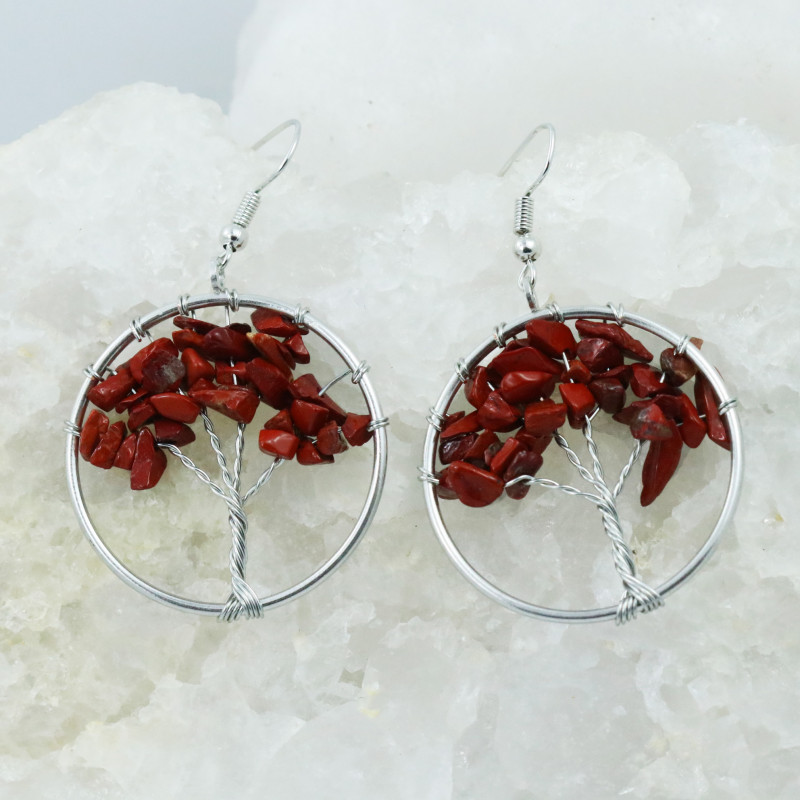
Sard Meaning & History
Sard has had various meanings ascribed to it since ancient times. In those times, sard symbolized bravery, protection, and joy. Similarly, sardonyx jewelry was a protective talisman worn by ancient Egyptians, Indians, and Romans.
More historical interpretations of sard’s meaning and powers include:
Protection during war — Roman soldiers
Warding off malevolent spirits & lowering crime — Egyptians
Protection from witchcraft — Mesopotamia & India
Preventing poverty, bringing success & joy — Prophet Muhammad
Accessing the power of Venus, goddess of love — Roman women
Increasing eloquence of speech — Renaissance-era Europeans
The term “sard” actually predates any term for quartz besides “crystal.” In the Old Testament of the Bible, sard is the first of 12 stones listed in Aaron’s (or the High Priest’s) Breastplate. It’s also described as symbolizing spiritual strength.
Ancient History
Ancient Roman scholar Pliny the Elder wrote the first official record of sard (or “sardius”) in his 77-AD work The Natural History. Pliny claimed the stone’s name honored the stone’s allegedly first discovery in Sardis (modern-day Sart, Turkey).
However, many scholars believe it derives from the Persian term sered, meaning “yellowish-red,” as its use pre-dates the Romans. The Roman empire was founded in 625 BC, but mining of sard began in the Bronze Age, (3300 BC-1200 BC). Uses for sard and sardonyx go back 4,000 years to ancient Egypt.
According to ancient Athenian orator Demostratus, the first Roman to wear sard was Africanus, the 2nd-century BC esteemed general. Demostratus credited Africanus with kickstarting sard’s prominence in Rome. Even the 1st-century AD Roman emperor Claudius Caesar favored sard and emerald adornments.

Sard Rings
One of the earliest and most prevailing uses for sard was in engraved rings. But what is a sard ring, and why is it important?
Sard rings were typically signet rings, carved inwardly as a cameo to press onto wax seals — similar to scarabs, another popular sard item.
One famous example is the sard or carnelian signet ring worn in the 7th-century AD by Islam’s founder, the Prophet Muhammad. He reportedly started wearing it in 630 AD to celebrate idols being removed from the Great Mosque of Mecca, the central pilgrimage location in Islam.
He also used it for sealing letters to the Romans (who only read sealed correspondence) and had the phrase “Muhammad the Messenger of Allah” engraved in Arabic. This type of ring, called an aqeeq ring, became an important Islamic symbol worn by Muslim men and women. Many have their sard rings carved with a prayer or evil eye.
Modern History
Both sard and carnelian were called “sardion” until the Middle Ages (500-1500 AD). During the 1600s, sard appeared in the mosaic-like inlay called parchin kari (or pietra dura) of the Taj Mahal in India.
Sard cabochons also appeared among the hundreds of 16th-century jewelry pieces of the “Cheapside Hoard” found in England in 1912. In Victorian England, sard was a favorite carving material for jewelry and seals.
Meanwhile, in 1800s-era Russia, acclaimed jewelry designer Gustav Fabergé carved sard figurines of Cossacks for Russian royals. Into the early 1900s, sardonyx carvings from Russia expanded into sculptures and paperweights that were also exported worldwide.
Today, sard doesn’t have the same level of fame. Healing-wise, what is sard used for today?

Sard Healing Properties
All chalcedony varieties, and gemstones for that matter, can be healing stones. Though carnelian is more popular for healing now, sard is still a strong healing crystal! As a predominantly brown gemstone, sard can inherently provide grounding, motivation, and stability.
For physical and emotional healing, what is the sardonyx crystal used for?
Physical Healing
Historically, folks used sard for protection against poison and venomous insect or animal bites. It was also popular for combating nightmares or other sleep issues.
For women, sard has long been recommended for easing childbirth and facilitating less painful pregnancies.
Emotional Healing
Emotionally, the sard stone benefits those struggling with self-doubt, negativity, or impulsivity. It’s said to replace these feelings with confidence, self-control, and happiness.
Sard may also help in relationships, both romantic and platonic. It’s believed to facilitate honest communication, encourage vulnerability, and increase selflessness, providing a stable foundation for growth.
Speaking of stable foundations…
Chakra Healing
Sard is a chakra stone for the root chakra, the foundation for stability, connection, and personal growth. Chakra crystals are used for addressing the negative side effects of a blocked chakra (energy point) by bringing it back into balance.
Located at the base of your spine, your root chakra may be blocked if you have pelvic discomfort or feel emotionally disconnected from others. Once you use sard to balance it, you can feel self-assured, grounded, and secure.
Of course, you’ll also want to feel assured that you’re getting a good deal when you’re buying sard gems. Let’s go over the value factors to look for!
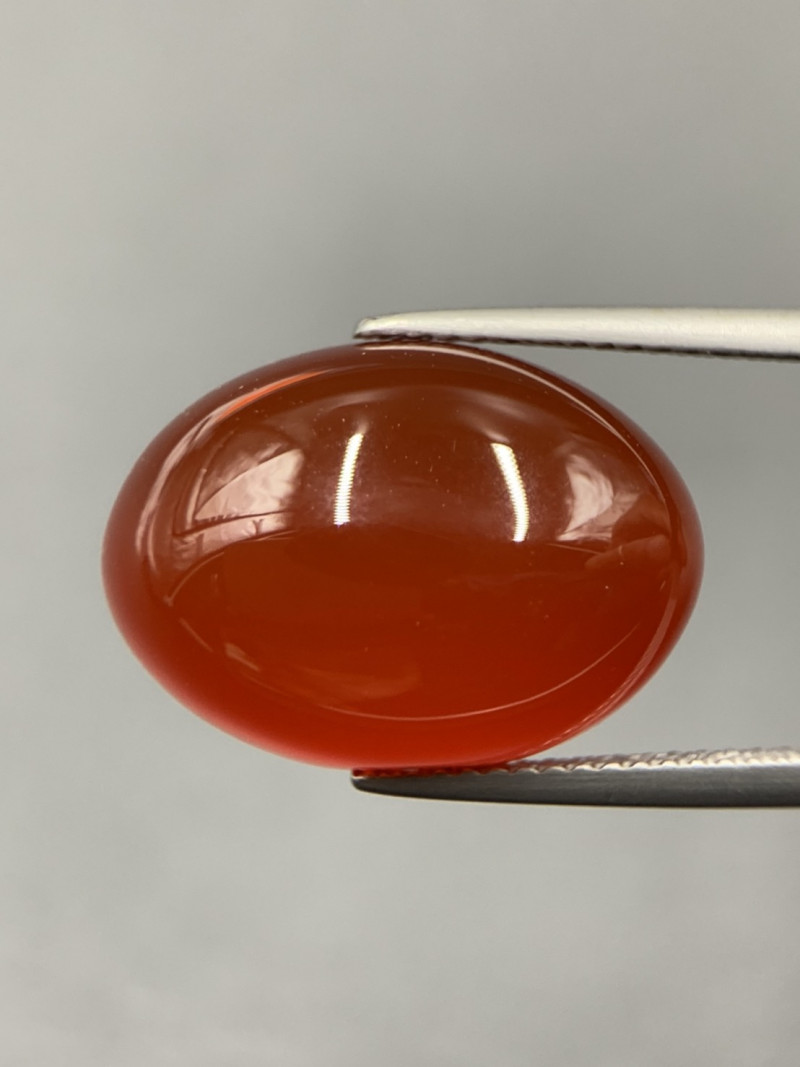
Sard Gemstone Properties
As an abundant gem, rarity doesn’t play a role in sard’s value the way it does for other stones. The gemstone properties that do influence its value are color, cut, transparency, and treatments.
Color
Sard is generally red to brown, commonly with orange and yellow undertones and sometimes white or dark inclusions that look cloudy. The stone’s color comes from impurities of iron oxide, often limonite. Brighter hues are most valuable, especially translucent sard that looks bright red in direct light.
Cut
Though carvings are the traditional choice, sard beads are most common today. Sard cabochons, often used in rings and pendants, are also common. You may see faceted pieces, but these are rarer.
Transparency
The stone is translucent to opaque, but translucent sard generally commands the highest prices.
Treatments
Chalcedonies were among the first artificially treated gems in history — 1300-BC heated carnelians were found in King Tut’s tomb!
One coloring treatment (less common today) was soaking and heating a chalcedony stone in a honey or sugar solution. Today, dark-hued sard is sometimes heated to create a lighter hue, as heat oxidizes the iron impurities.
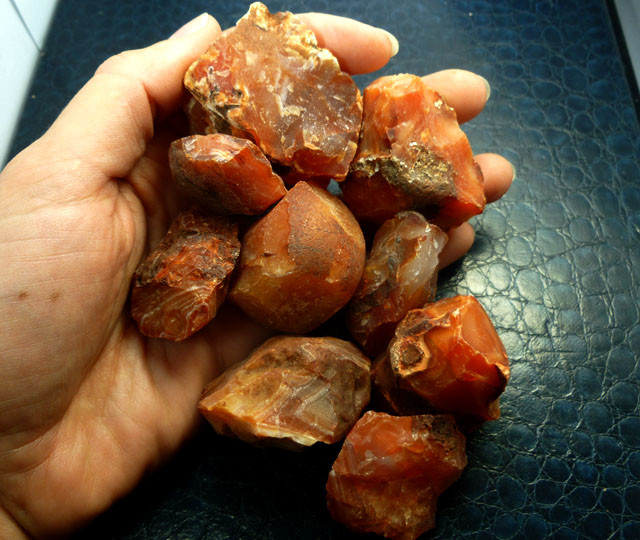
Sard Formation & Sources
Like all chalcedonies, sard forms at fairly low temperatures when groundwater carrying silica seeps into rock crevices. The water can also dissolve materials, allowing the silica to take their place as it hardens into sard.
Usually, sard forms close to Earth’s surface inside lava rocks as the rocks themselves cool, having been shot to the surface as magma. Water deposits silica in open spaces within the rock, then evaporates, allowing the silica to harden into sard. Before it completely hardens, iron oxide slips in to give it its earthy hue.
Mining Locations
India is famous for producing the highest-quality sard and sardonyx stones.
Sard also comes from:
Brazil
Germany
Italy
Mongolia
Peru
Poland
Russia
Sri Lanka
Uruguay
USA (California, Connecticut, New Jersey, New Mexico)
Finally, how much is sard worth? Good news: it’s super affordable!

Sard Price & Value
At wholesale, sard cabochons weighing from 1 ct to nearly 18 cts each cost around $14. Faceted sard gems start at $5 and usually don’t exceed $15, with the exception of some lighter-colored stones around $40.
Jewelry-wise, sard pendants typically go for around $30-$40. Pricier options include more expensive gems like diamonds.
Signet rings are more expensive, as most are antique, hand-carved, and placed in high-quality gold settings. The sterling silver rings are at the lower end, around $50-$100, while gold-set rings range from $270 to $8,000 or more.
Sard Care and Maintenance
Sard gemstone care is easy, as it doesn’t break easily. Still, it can chip from ultrasonic cleaners, so don’t use that cleaning method. Instead, use a soft, microfiber cloth and warm water mixed with mild soap. Dry it with another soft cloth and store it separately from other gems to avoid scratches.
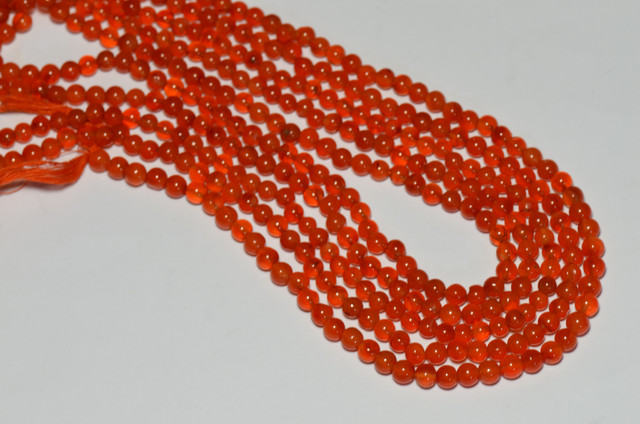
Want an Ancient and Accessible Treasure?
Don’t judge a gemstone by its name — because sard defies expectations! It’s rare for a gemstone with such a long history that has adorned both royalty and regular folks alike, but sard is an anomaly of the best kind.
To quote the German poet Johann Wolfgang von Goethe discussing sard, “From such a gem a woman gains sweet hope and comfort in her pains.”
If you’re looking for a legendary gem for protection, happiness, and success, turn to the tried-and-true sard crystal!
Search the Gemstone Encyclopedia
Related Auctions
Related Articles
Everyone has a gemstone that corresponds with their star sign. These are also known as your Star Stone. Learn more about these stones and find out what your Star Stone is.
10th May 2018
Originally the Birthstones or gemstones were associated with a zodiac sign or the month of a individuals birth. Find out what your stone is and view the stones we have for sale
8th Feb 2021
There are so many tools on the market for testing a gemstone, but what are the main tools required for simple analysis. Lets look at four tools for gemstone testing.
4th Mar 2020
Latest Articles
Yugawaralite is a rare colorless, white, or pinkish zeolite crystal named for its discovery in Yugawara, Japan. Here we uncover the multifaceted history, properties, prices, and uses of yugawaralite.
24th Mar 2025
Simpsonite is a lesser-known mineral known on the gem market for its durability, yellow-orange color, and rarity. Discover all the properties, uses, prices, and history of simpsonite.
3rd Mar 2025
Kurnakovite is a colorless crystal related to inderite and rarely faceted but known among collectors. Explore the mineral traits, history, prices, and more in this kurnakovite guide.
17th Feb 2025
Article Categories
How To's is where you will find helpful articles from gem Rock Auctions on how to cut gemstones, select gemstones and buy gemstones.
9 Articles



